Who's Your Daddy?
Dr. Jenna Dockweiler, Embark DNA Test
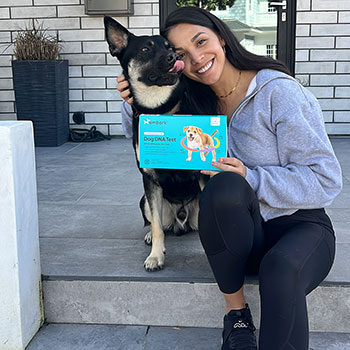 We have Pixel, the Animal Radio studio stunt dog in studio today. She's usually here with us, but we have her in here today for something very special. We rescued Pixel about two and a half years ago. She was from a litter of seven, and all of the puppies looked so different.
One of the other rescuers did a DNA test on their puppy from this same litter. Judy was then told that those results came back as a Jack Russell and Chihuahua. But when people see Pixel, they always guess many other different breeds.
It made us wonder. Was Pixel really a part of this litter? They were brought to Colorado from Texas, so perhaps they had a single stray pup that they just put in with this other litter for transport?
Judy has mentioned several times over the last couple of years that she wanted to get a DNA test done.
So why does it matter? We are going to love her anyway, right? However, when people guess what she is, we would like to know, so we can say you're right or you're wrong. And plus, we just wanted to know for other reasons like the risk of medical issues she may have inherited.
That’s when we came upon the Embark DNA test and contacted Dr. Jenna Dockweiler from Embark.
We gave her some background information on Pixel, telling her how she looked very different from her siblings. We asked her if puppies in a litter could have different dads? And if so, how does that work? Dr. Jenna Dockweiler explained that dogs can have litters with multiple fathers. It's a phenomenon called superfecundation.
Dogs actually release their eggs over a pretty long period of time, actually several days, which offers the opportunity to mate with multiple males during that time. They have a pretty long fertile period. So sometimes if you see a litter where the puppies just look completely different from each other, they might actually be half siblings and not full siblings.
Thanks to Dr. Jenna Dockweiler, we received an Embark DNA test kit that we are going to use today on Pixel, the Animal Radio Studio Stunt Dog. But before we do, we have a lot of questions:
Hal: I have a friend who has a dog. My friend says that it's a Lab, Rhodesian Ridgeback, Collie mix. So there’s three different breeds she just listed. Wouldn't it be just two breeds, mom and dad? Or does that go back lineage-wise for like the grandpa and grandma?
Dr. Jenna Dockweiler: If you have two purebred parents, then we would only have two breeds in that mix. But, certainly if we have mixing that happened further back, we can have three, four, five, six and even seven. We can end up with a lot of different breeds in an individual mixed breed dog.
Hal: The Embark DNA test is going to tell us not only the breed, but what else?
Dr. Jenna Dockweiler: The Embark DNA test also tests for, in addition to the over 350 breeds and varieties, over 270 known genetic health conditions and over 55 physical traits.
Judy: Regarding these health conditions that may show up, are they something your dog has or may develop?
We have Pixel, the Animal Radio studio stunt dog in studio today. She's usually here with us, but we have her in here today for something very special. We rescued Pixel about two and a half years ago. She was from a litter of seven, and all of the puppies looked so different.
One of the other rescuers did a DNA test on their puppy from this same litter. Judy was then told that those results came back as a Jack Russell and Chihuahua. But when people see Pixel, they always guess many other different breeds.
It made us wonder. Was Pixel really a part of this litter? They were brought to Colorado from Texas, so perhaps they had a single stray pup that they just put in with this other litter for transport?
Judy has mentioned several times over the last couple of years that she wanted to get a DNA test done.
So why does it matter? We are going to love her anyway, right? However, when people guess what she is, we would like to know, so we can say you're right or you're wrong. And plus, we just wanted to know for other reasons like the risk of medical issues she may have inherited.
That’s when we came upon the Embark DNA test and contacted Dr. Jenna Dockweiler from Embark.
We gave her some background information on Pixel, telling her how she looked very different from her siblings. We asked her if puppies in a litter could have different dads? And if so, how does that work? Dr. Jenna Dockweiler explained that dogs can have litters with multiple fathers. It's a phenomenon called superfecundation.
Dogs actually release their eggs over a pretty long period of time, actually several days, which offers the opportunity to mate with multiple males during that time. They have a pretty long fertile period. So sometimes if you see a litter where the puppies just look completely different from each other, they might actually be half siblings and not full siblings.
Thanks to Dr. Jenna Dockweiler, we received an Embark DNA test kit that we are going to use today on Pixel, the Animal Radio Studio Stunt Dog. But before we do, we have a lot of questions:
Hal: I have a friend who has a dog. My friend says that it's a Lab, Rhodesian Ridgeback, Collie mix. So there’s three different breeds she just listed. Wouldn't it be just two breeds, mom and dad? Or does that go back lineage-wise for like the grandpa and grandma?
Dr. Jenna Dockweiler: If you have two purebred parents, then we would only have two breeds in that mix. But, certainly if we have mixing that happened further back, we can have three, four, five, six and even seven. We can end up with a lot of different breeds in an individual mixed breed dog.
Hal: The Embark DNA test is going to tell us not only the breed, but what else?
Dr. Jenna Dockweiler: The Embark DNA test also tests for, in addition to the over 350 breeds and varieties, over 270 known genetic health conditions and over 55 physical traits.
Judy: Regarding these health conditions that may show up, are they something your dog has or may develop?
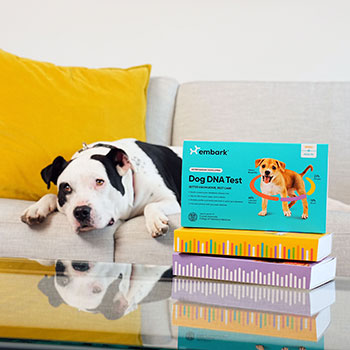 Dr. Jenna Dockweiler: A DNA test is only able to tell us if there is a risk for a genetic disease.
Hal: How accurate are these tests?
Dr. Jenna Dockweiler: The Embark DNA test is over 99-percent accurate. We are very proud to have the most robust reference panel for that breed ancestry identification. We have a lot of different quality checks on their health and trait markers to ensure accuracy. It's really very important to select a reputable DNA testing company, because animal genetic testing is actually not regulated at all. This means that the company is going to have to hold itself to a high standard. So at Embark, we are CLIA certified and follow ISO standards. Those are human laboratory quality measures.
Judy: We previously did a DNA test on a dog over 15 years ago. Have these tests come a long way since then?
Dr. Jenna Dockweiler: They have come a very long way since then. If you go back kind of to the beginning of canine genetics, they have Tasha the boxer, who was the first dog to have her whole genome sequenced. That only happened in 2005. So it's only been 20 years since that point. So if you're talking about DNA tests that were 10 or 15 years ago, there's been a lot of advancements since that time.
Dr. Jenna Dockweiler also explains that anybody who's been tested on their platform and has opted in to being findable on the relative finder platform, such as siblings or parents, Embark has created a way to message one another on the platform.
Animal Radio has one of these tests that we're going to do on Pixel. Hal brushes Pixel’s teeth daily, so this should be pretty easy.
The kit contains a tube with purple liquid in it and a cotton swab at the end of that. Before doing the test, you need to wait at least 30 minutes after your dog eats. You then swab the insides of their cheeks. You can do both sides if they allow you to. If Embark can't read a swab for whatever reason, they will send a replacement free of charge.
When you’re done, you put the swab back into the tube containing the DNA-stabilizing fluid, facing down this time, and then shake the tube. It’s so easy to do.
Next, you just pop the tube in the little clear plastic pouch, and place that in a padded mailer that's prepaid for USPS.
You will then get the results two to four weeks after they receive that swab at their lab. Embark will send an email when results are ready and then you'll be able to log into your account, the same account you activated when purchasing the test.
Have you ever wondered what kind of breed your dog is? Then what are you waiting for! You can order an Embark DNA test online at EmbarkVet.com. It costs $199 for a full breed and health test. That includes over 350 breeds and varieties, over 200 health conditions and physical traits, as well as some other fun things like relative finder, where you can find other dogs related to yours. And, if you put in the promo code "AnimalRadio," you can get $10 off.
Visit Website
Dr. Jenna Dockweiler: A DNA test is only able to tell us if there is a risk for a genetic disease.
Hal: How accurate are these tests?
Dr. Jenna Dockweiler: The Embark DNA test is over 99-percent accurate. We are very proud to have the most robust reference panel for that breed ancestry identification. We have a lot of different quality checks on their health and trait markers to ensure accuracy. It's really very important to select a reputable DNA testing company, because animal genetic testing is actually not regulated at all. This means that the company is going to have to hold itself to a high standard. So at Embark, we are CLIA certified and follow ISO standards. Those are human laboratory quality measures.
Judy: We previously did a DNA test on a dog over 15 years ago. Have these tests come a long way since then?
Dr. Jenna Dockweiler: They have come a very long way since then. If you go back kind of to the beginning of canine genetics, they have Tasha the boxer, who was the first dog to have her whole genome sequenced. That only happened in 2005. So it's only been 20 years since that point. So if you're talking about DNA tests that were 10 or 15 years ago, there's been a lot of advancements since that time.
Dr. Jenna Dockweiler also explains that anybody who's been tested on their platform and has opted in to being findable on the relative finder platform, such as siblings or parents, Embark has created a way to message one another on the platform.
Animal Radio has one of these tests that we're going to do on Pixel. Hal brushes Pixel’s teeth daily, so this should be pretty easy.
The kit contains a tube with purple liquid in it and a cotton swab at the end of that. Before doing the test, you need to wait at least 30 minutes after your dog eats. You then swab the insides of their cheeks. You can do both sides if they allow you to. If Embark can't read a swab for whatever reason, they will send a replacement free of charge.
When you’re done, you put the swab back into the tube containing the DNA-stabilizing fluid, facing down this time, and then shake the tube. It’s so easy to do.
Next, you just pop the tube in the little clear plastic pouch, and place that in a padded mailer that's prepaid for USPS.
You will then get the results two to four weeks after they receive that swab at their lab. Embark will send an email when results are ready and then you'll be able to log into your account, the same account you activated when purchasing the test.
Have you ever wondered what kind of breed your dog is? Then what are you waiting for! You can order an Embark DNA test online at EmbarkVet.com. It costs $199 for a full breed and health test. That includes over 350 breeds and varieties, over 200 health conditions and physical traits, as well as some other fun things like relative finder, where you can find other dogs related to yours. And, if you put in the promo code "AnimalRadio," you can get $10 off.
Visit Website
Dances With Raccoons
Mark "Coonrippy" Brown
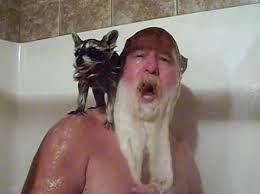 Mark "Coonrippy" Brown's YouTube videos went viral. He became famous for a video that showed him and his pet raccoon, Gunshow, dancing to Aretha Franklin. But the increased scrutiny on his lifestyle caused the Tennessee Wildlife Resources Agency (TWRA) to step in and confiscate another pet 'coon, Rebekah. (Gunshow had since moved on to raccoon heaven.)
Mark "Coonrippy" Brown's YouTube videos went viral. He became famous for a video that showed him and his pet raccoon, Gunshow, dancing to Aretha Franklin. But the increased scrutiny on his lifestyle caused the Tennessee Wildlife Resources Agency (TWRA) to step in and confiscate another pet 'coon, Rebekah. (Gunshow had since moved on to raccoon heaven.)
Brown posted dozens of YouTube videos featuring wild raccoons he treats as pets and applied for a permit to keep Rebekah. In one edition, Gunshow the raccoon sips Pepsi from the bottle. In another, which was featured by national media outlets and "The Tonight Show," Brown uses Hannah Montana body spray to keep Gunshow from nibbling at his side. Brown posted a memorial video when Gunshow passed away. Together, the collection of videos racked up millions of views.
Unfortunately, TWRA officers seized the young Rebekah after a tipster pointed them toward a video of Brown shampooing his long white beard with the soggy raccoon perched on his shoulder. An official said Brown was breaking state law by keeping Rebekah as a pet. Because he voluntarily turned her over, he wasn't cited.
Brown, who at one time was a Licensed Nuisance Wildlife Remover by the TWRA, had Gunshow for 4 years. He originally captured Gunshow's mother in an attic of a house and relocated her not knowing that there was a baby inside the walls. Brown found Gunshow when he was about 2-3 weeks old. He called the TWRA to come and get him. Unfortunately, 3 days and 3 phone calls later, no one from TWRA ever responded. Those 3 days turned into a week, the week turned into a year and the year turned into 4 years. As a result, Brown ended up raising Gunshow.
With Rebekah, Brown felt it wouldn't do any good to call the TWRA, as they never responded when he contacted them for Gunshow.
While our own Dr. Debbie sympathizes with the problem, she doesn't advocate wild animals as pets. She states that as far as raccoons go, you can tame them, but they never become domesticated. But even worse, raccoons are the number one carrier of rabies in the United States and there is currently no valid rabies vaccine for raccoons. They also carry a type of roundworm called baylisascaris, which has the unpleasant side affect of migrating in other animals and people, which can cause neurological problems and death.
While Brown is an exception and knows what he is doing, it is still discouraged for anyone else to feel they can take on one of these animals.
Brown lives in a large wooded area with 13 acres of it being his private property and has no neighbors. He is known for his good deeds. He feels the focus of wildlife officials should be on those committing real crimes against wildlife.
Cross-Country Trip With 25 Dogs
David Rosenfelt, Dogtripping
 When mystery writer David Rosenfelt and his family moved from Southern California to Maine, he thought he had prepared for everything for the move with his many dogs.
When mystery writer David Rosenfelt and his family moved from Southern California to Maine, he thought he had prepared for everything for the move with his many dogs.
They had mapped the route, brought three GPSs for backup, as well as refrigerators full of food, and stoves and microwaves on which to cook them.
But traveling with twenty-five dogs turned out to be a bigger ordeal than he anticipated, despite the 3 RVs, the extra kibble, volunteers (including a few readers), and camping equipment.
David and his wife originally had a rescue foundation in California, through which they saved about 4,000 dogs. If they rescued a dog that was too old, blind or even epileptic and nobody else wanted them, the dogs came home as their pet. This means that they always had between 20 and 40 dogs at one time.
At the time David's wife retired and they were ready to move to their house in Maine, they had 25 large dogs and had to figure out how to get there with everyone.
 They explored many modes of transportation, but flying unfortunately wasn't a practical way to go for their old, arthritic dogs. It seemed the only way to go was by vehicle and RV's seemed the most practical, which would take about a week.
They explored many modes of transportation, but flying unfortunately wasn't a practical way to go for their old, arthritic dogs. It seemed the only way to go was by vehicle and RV's seemed the most practical, which would take about a week.
But this lead to other problems. How were they going to stop and walk the dogs and let them out for potty breaks? It wasn't easy, but they ended up getting 250 feet of plastic fencing, which they had to unroll each time and set up their own dog parks.
They also had 9 volunteers with them, which were mainly readers of David's mystery books and people they didn't even know. David didn't originally invite these people along. Since David didn't know how to move his dogs across the country, he sent out emails and put posts on FaceBook asking people how to make the move. In the process, people stated that they wanted to be part of it. David even mentioned to one volunteer they he wouldn't know if they were a serial killer, but the thought of traveling with a serial killer as opposed to doing it by himself, was fine by him!
While David said he was completely miserable the entire trip, the volunteers thought it was the greatest adventure of their lives!
You can read more about his adventures in his book, Dogtripping!
Visit Website
Get Your Pet To the Vet Safely with No Escapees - Dr. Debbie
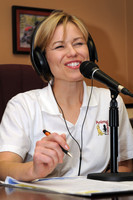 A frightening situation occurred at my veterinary hospital. Working inside my office, I heard a woman's shrieks coming from the parking lot. I ran outside to find a woman with one dog on a leash and the other dog skittering about the parking lot - the result of a slipped collar. The owner would approach the panicked dog and he'd retreat, darting under nearby cars. Those familiar with our hospital location understand its proximity to a busy intersection. Should the dog run in the wrong direction, he'd meet up with 45 mph traffic.
A frightening situation occurred at my veterinary hospital. Working inside my office, I heard a woman's shrieks coming from the parking lot. I ran outside to find a woman with one dog on a leash and the other dog skittering about the parking lot - the result of a slipped collar. The owner would approach the panicked dog and he'd retreat, darting under nearby cars. Those familiar with our hospital location understand its proximity to a busy intersection. Should the dog run in the wrong direction, he'd meet up with 45 mph traffic.
My staff was outside in moments to assist the owner in retrieving her dog and safely escorted everyone into the building. Thankfully, my client's few minutes of terror ended uneventfully. But that's not always the case. I've seen dogs run straight into the road, cat's leap from a family member's arms, and owners dive into oncoming traffic trying to catch an escaping pet.
The lesson is simple. Don't underestimate your pets' fears. Fear of car travel, new places or the veterinary office can cause a pet to behave in unpredictable ways. If you know your pet to be nervous with new people or new situations, be especially vigilant when transporting your pet in a vehicle.
Identify Your Pet
Use two methods of identification for best insurance your pet is returned to you if lost. Permanent identification with a microchip is a must and should be complimented with a collar and ID tags.
Restrain Pet in Vehicle
Keep your pet secure during travel and when the car door opens by using a doggie seatbelt. Small dogs and cats should be housed in a pet carrier which is secured with seatbelt to avoid undue carrier movement during travel. Do not allow cats and small pets to roam freely in the car. Cats have been known to take cover under car seats which may require sedation or seat removal to extract kitty from her hiding place.
Check for Proper Fit
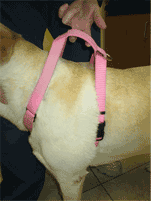

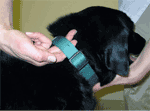 A proper fitting collar allows 2 finger widths between the collar and pet's neck. Allow more than, and should your pet put on the brakes, he'll easily slip out of the collar. Poor fitting harnesses are just as dangerous and allow gap room which allows a back-peddling pet to wiggle out. Not sure if the collar is too loose? Snug the collar up one fitting in anticipation of your trip to the vet.
A proper fitting collar allows 2 finger widths between the collar and pet's neck. Allow more than, and should your pet put on the brakes, he'll easily slip out of the collar. Poor fitting harnesses are just as dangerous and allow gap room which allows a back-peddling pet to wiggle out. Not sure if the collar is too loose? Snug the collar up one fitting in anticipation of your trip to the vet.
Try Other Collar Styles
Even if you don't normally use a choker or pinch collar, consider using one when going to the vet's office. For thick necked dogs with smaller head size, try the Martingale collar, a fabric and metal combo collar that snugs down should your dog try to back out. Boisterous dogs that jump and leap when on leash may benefit wearing a head collar that fits over the muzzle. Ensure your collar choice is properly fitted, since any of these styles can fail if improperly fitted or used incorrectly.
Call Ahead
If you anticipate difficulties getting your pet to the vet's office, call ahead. Veterinary staff members are on the ready to help ensure your pet's visit is a safe one.
So, take a few minutes to consider your pet's travel safety before heading out on that next car trip, whether it is to the park, groomer or veterinary office. Your four legged friend will thank you, but may pout on the way there.
Featured veterinarian known as "Dr. Debbie" on national pet radio program, Animal Radio. Ebook author of "Yorkshire Terriers: How to Be Your Dog's Best Friend"; "Pugs: How to Be Your Dog's Best Friend"; "Mini Schnauzers: How to Be Your Dog's Best Friend"; and "Shih Tzu: How to Be Your Dog's Best Friend." Dr. Debbie's books.
Visit Website
Animal Radio News with Stacey Cohen
 Kangaroo Censorship PG
Kangaroo Censorship PG
An act of Kangaroo censorship left some people hopping mad. Tourism Australia originally posted a photo of a Kangaroo named Big Baz on their FaceBook page. But since Big Baz was sprawled out on his back in the pic, they chose to keep it PG by pixelating the animal's private parts. The folks explained that they were only having a bit of fun, but not everyone thought it was very funny. More than 1,600 people commented on the photo, with many calling the censorship stupid, crazy and everything in between. One user even accused Tourism Australia of trying to turn Big Baz into a centerfold model. The agency then replaced the photo with another that was slightly more modest, joking that Big Baz had since "taken to being a little camera shy."
No Ordinary Fish Tale
A German angler was credited with catching a massive 513-pound halibut off the coast of Norway. The monster fish could claim the record for the largest halibut ever reeled in with a fishing rod. The angler said the nine-foot sea dweller put up a 90-minute fight.
 Cat Burglar Was A Cat!
Cat Burglar Was A Cat!
The owners of an actual cat burglar tried to bring an end to their feline companion's "life of petty crime." A couples' two-year-old tabby had been building quite the collection of stolen goods from their neighbors' homes. The cat supposedly started small by nabbing the occasional dishcloth, but then began swiping bras, pants and t-shirts. The owners thought it was funny at first, but they soon realized they had to find a way to return the goodies that their cat brought home. They started writing letters to their neighbors explaining the situation and all of them were good-natured. The owners started ignoring Norris when he showed off his goods in hopes that he would stop his thievery.
Mexican Made Rat-Ketchup
When the Heinz Tomato Ketchup slogan was "Good things come to those who wait," they probably didn't mean a tangled mess of rat fur. Health officials in Brazil banned a Mexican-made batch of everyone's favorite condiment after they detected "traces of rodent fur" in the bottles, which were imported into the country. The tainted bottles reportedly were pulled from store shelves, and the Brazilian government banned any "sales, distribution and marketing" of units from that batch. Mexico's own authorities stepped in, launching an inspection of the factory where the ketchup was made.
 Sea Snail Hatched In Boy's Knee
Sea Snail Hatched In Boy's Knee
A boy from California was unfazed after a snail emerged from a cut on his knee. The snail of a tale began when the boy tripped and fell during a camping trip near the beach. His fall left him with what his parents believed was nothing more than a scraped knee. However, when the wound was still swollen three weeks later they began to worry. His mother noticed a "big puss ball" on her son's knee that had a black hue. She decided to pop the pustule and said, "A snail popped out." At first she thought it was a rock, but on closer inspection she noticed it was snail shell. The family believed that when their boy cut his leg, a sea snail egg managed to get into the wound. The boy ended up naming the snail Turbo, after the DreamWorks animated film, which was based on a story about a snail. The snail survived for one day, but then unfortunately died.
 Listen to the entire Podcast of this show (#1338)
Listen to the entire Podcast of this show (#1338)





